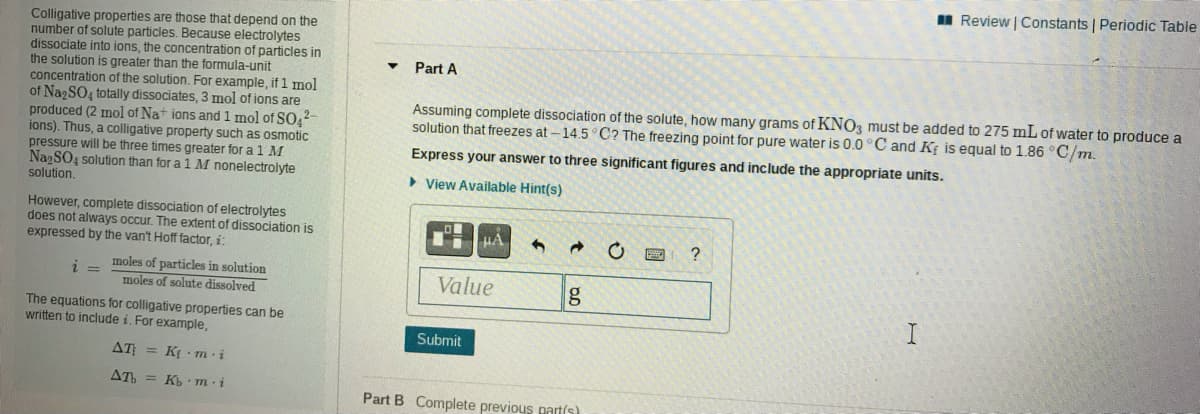Part A Assuming complete dissociation of the solute, how many grams of KNO3 must be added to 275 mL of water to produce a solution that freezes at -14.5 C? The freezing point for pure water is 0.0°C and Kţ is equal to 1.86°C/m. Express your answer to three significant figures and include the appropriate units. > View Available Hint(s) HA Value
Part A Assuming complete dissociation of the solute, how many grams of KNO3 must be added to 275 mL of water to produce a solution that freezes at -14.5 C? The freezing point for pure water is 0.0°C and Kţ is equal to 1.86°C/m. Express your answer to three significant figures and include the appropriate units. > View Available Hint(s) HA Value
Chapter79: Solubility
Section: Chapter Questions
Problem 1P
Related questions
Question
100%

Transcribed Image Text:I Review | Constants | Periodic Table
Colligative properties are those that depend on the
number of solute particles. Because electrolytes
dissociate into ions, the concentration of particles in
the solution is greater than the formula-unit
concentration of the solution. For example, if 1 mol
of NazSO, totally dissociates, 3 mol of ions are
produced (2 mol of Nat ions and1 mol of SO,?-
ions). Thus, a colligative property such as osmotic
pressure will be three times greater for a 1 M
NazSO, solution than for a 1 M nonelectrolyte
solution.
Part A
Assuming complete dissociation of the solute, how many grams of KNO3 must be added to 275 mL of water to produce a
solution that freezes at -14.5°C? The freezing point for pure water is 0.0 °C and Kf is equal to 1.86 °C/m.
Express your answer to three significant figures and include the appropriate units.
> View Available Hint(s)
However, complete dissociation of electrolytes
does not always occur. The extent of dissociation is
expressed by the van't Hoff factor, i:
HA
moles of particles in solution
moles of solute dissolved
Value
2 =
The equations for colligative properties can be
written to include i, For example,
Submit
AT = K - m i
ATb = Kb m-i
Part B Complete previous partís)
Expert Solution
Step 1
Given data:
- 275 mL of water
- Freezing point of solution is -14.5oC
- Kf = 1.86oC/m
- Freezing point of pure water = 0oC
Trending now
This is a popular solution!
Step by step
Solved in 2 steps

Knowledge Booster
Learn more about
Need a deep-dive on the concept behind this application? Look no further. Learn more about this topic, chemistry and related others by exploring similar questions and additional content below.Recommended textbooks for you

EBK A SMALL SCALE APPROACH TO ORGANIC L
Chemistry
ISBN:
9781305446021
Author:
Lampman
Publisher:
CENGAGE LEARNING - CONSIGNMENT

Introductory Chemistry: An Active Learning Approa…
Chemistry
ISBN:
9781305079250
Author:
Mark S. Cracolice, Ed Peters
Publisher:
Cengage Learning


EBK A SMALL SCALE APPROACH TO ORGANIC L
Chemistry
ISBN:
9781305446021
Author:
Lampman
Publisher:
CENGAGE LEARNING - CONSIGNMENT

Introductory Chemistry: An Active Learning Approa…
Chemistry
ISBN:
9781305079250
Author:
Mark S. Cracolice, Ed Peters
Publisher:
Cengage Learning


Principles of Modern Chemistry
Chemistry
ISBN:
9781305079113
Author:
David W. Oxtoby, H. Pat Gillis, Laurie J. Butler
Publisher:
Cengage Learning